All about pool dance
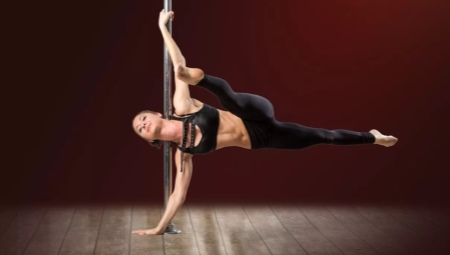
Pool dance is a direction, as controversial as it is interesting. You will no longer be surprised by the fact that pool dance competitions are held, festivals are organized, children and adults are engaged in it. And all this is under the "sauce" of the stereotypes that surround this dance since its inception.
What it is?
Pool dance is an intense dance that uses a pole or pole as an instrument. This includes dance plastics and serious physical activity with elements of acrobatics and gymnastics. Of course, this direction is very spectacular, but you definitely cannot call it simple. The dance consists of a large number of groups of movements that are aimed at muscle development, stretching and general grace.
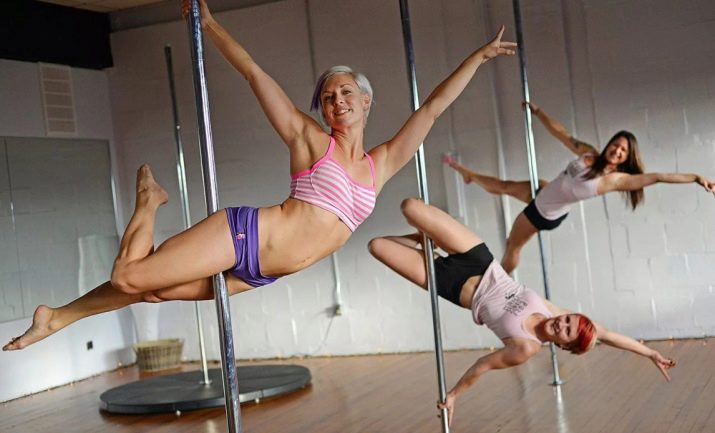
The most common question: "Isn't this a striptease?" No, it is rather ignorant to think that they are really the same thing. To begin with, it is not customary to undress in pool dance. Yes, the dance presupposes a stage outfit, but only this at the beginning and at the end of the number remains with the artist. Next is the place of performance. In pool dance, official competitions are held, where dancers of different age categories perform, and children too. No one has the goal of creating a performance similar to a show in a nightclub: here the task is different - to show the capabilities of the human body, plasticity, flexibility and grace, using such an instrument as a pylon.
Those who initially see some dubious subtext in this direction are unlikely to be dissuaded. Unless he himself sees the classes: how they go, how the coach works with the students, what kind of preparation is required to perform on the pole.
Yes, a certain analogy with a show for adults may arise, but if the work is a master, and in the performance - great physical fitness, impeccable aesthetics and professionalism, even the bigots take off their hats.
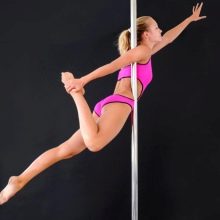
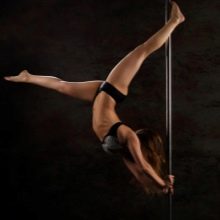

Who is the dance for?
In itself, the answer suggests itself - to those who have no prejudices. Usually active, physically active people who love dance and sports come to pool dance, who are interested in trying something new. The trend, although fashionable, is still not well known. In small towns, most likely, you will not find a studio and a coach, but those who live in large centers should look for it.
The professionals themselves say that pool dance is suitable for people:
- with different levels of build and training;
- of different ages - there are championships in which only dancers 40+ participate;
- ready for serious stress.
The lower age limit for pool dance is 11-12 years old. And not every child is suitable for such an activity: you need to take into account certain physical indicators, individual abilities.
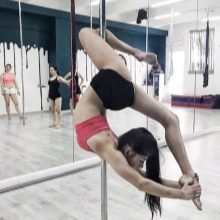
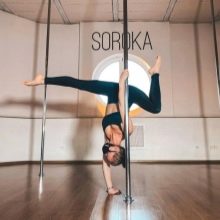
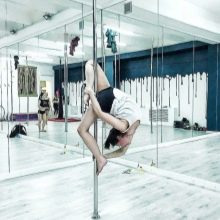
Species overview
The relatively young dance also acquired several directions. And each - with an emphasis on an additional component, that is, it is a mix of two types of activity, the combination of which gives a beautiful result.
Pole Art
In this direction, the combination of dance and power elements is considered the most harmonious. More precisely, these components are used equally in this form. Artistry is assessed during the performance of the participants, as well as the clear performance of tricks and power techniques. Grace and choreographic skills are required. It is important to maintain the dance in an appropriate manner for the performer, there must be organic in the act and appearance of the artist.
The technical complexity of the elements in this type of pool dance is not so valuable, but the integrity of the image and the general presentation are the very essence of the number. By the way, participants wearing leather and latex elements and lacquer may not be allowed to compete in this form. And this is not only because these materials do not provide proper adhesion to the pylon.
Excessive sexualization of the image, as well as shoes with very high heels (strips) are also prohibited.
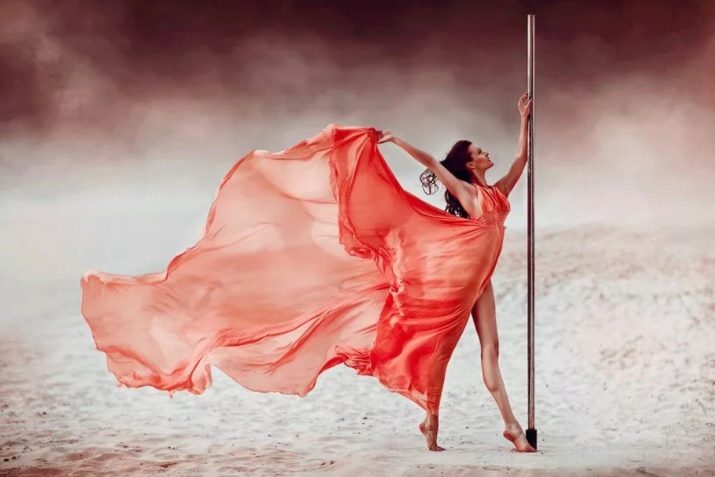
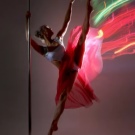
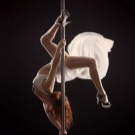
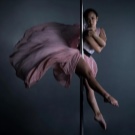
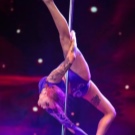
Pole Sport
But this direction is interesting because it may soon be included in the program of the Summer Olympic Games. Here the image of the artist is already much less important, because trick and power elements enter the arena. The judges will be judged by their impeccable performance. Clothing should be rather neutral. Shoes are excluded altogether, shoes can either be absent altogether, or be special sports shoes.
There are also quite strict regulations: for example, the number of touches to the floor is limited, the number of mandatory elements and their sequence are determined. In this sense, the direction is very close to figure skating and rhythmic gymnastics. The dance part will only dilute the number, it serves to link the elements, nothing more. Stunt and strength elements are the main thing and what makes the competitive part entertaining. Tricks in the number should be 70% of the time, everything else can be given to the bundles.
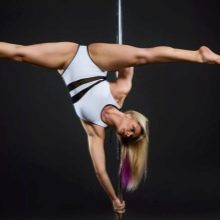
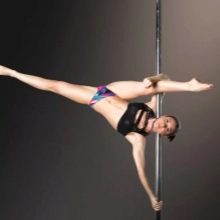
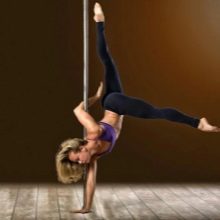
Exotic Pool Dance
Here, strip plastic is connected, which can be understood by the name of the direction. Already not only acrobatic stunts become the goal of the performance, but also spectacular dance combinations. There is a lot of emotionality here, it is often called “not a dance, but an impulse of the soul”. There is both passion and eroticism, therefore the direction is considered specific: naturally, such a variation of the genre is not suitable for everyone.
And even this type is divided into subspecies: exotic old school is the most eroticized category with an emphasis on the sensuality and seductiveness of the dancer, exotic hard is much more trick, while you need to move on those same strips, and exotic flow is the dance of the stream.


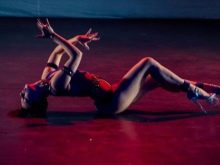
Pole Fitness
This direction is very similar to the sports one, but the requirements will be a little softer. Since sports are different from fitness, pool sports are different from pool fitness. A good option for those who want to start from scratch and sensibly assess the level of their capabilities. And also for those who are not going to storm the championship podiums, but intend to engage in beautiful physical activity just for themselves.
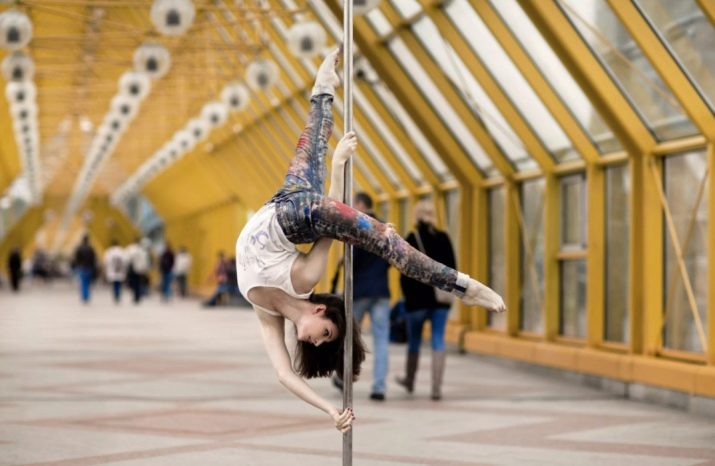
Pole contemporary
The basis here is choreography with its classical aesthetics, purity of movements, penetration and ability to express themselves vividly. So far, this direction has not gained due popularity in Russia, although it is probably the most promising - the audience is more loyal to it. Balance, turnout, endurance, these are what you will especially have to work on in the classroom.
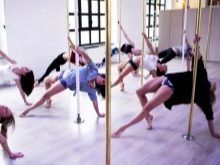

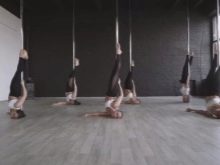
Main elements
In order to understand a little about pool dance, not only theoretically, you should try the base - the main elements and ligaments that make up the backbone of the direction.
- "Slingshot" (or "raznozka"). This is hanging on a pylon, head down. The buttocks should be higher than the head, the legs spread apart in different directions. Hands are between the inner thighs, you need to hold on to the pylon strongly.
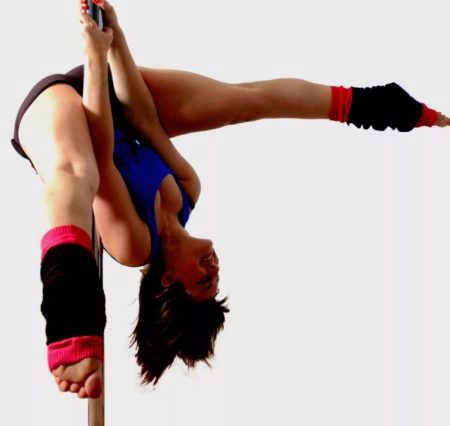
- "Birdie" is a simple element. You need to pull yourself up with your hands, wrap your legs around the pylon, tilt your body to the side. The tilt of the body and the position of the hips will prevent the legs from sliding along the pylon. It must be grasped under the knee of the leg, towards which the body deviates. He should go even further ahead of the pylon.

- "Spider". Perform this trick for the base level from hanging on the far leg. You need to pull up, throw the other leg in front of the pole, hook it under the knee. Lowering your hands will make the trick more difficult.
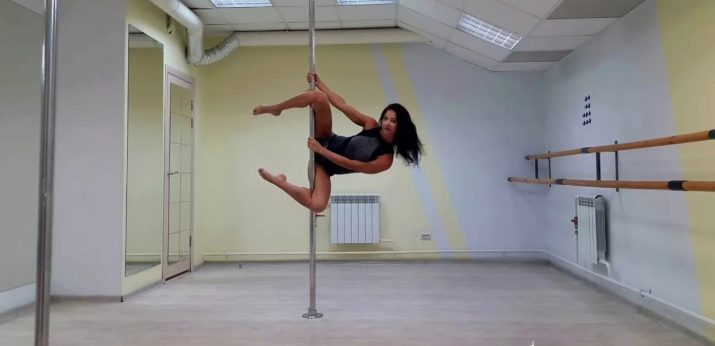
- "Martini". Hanging is done on the far leg, you need to get up and throw the second leg, grab it with the opposite hand. The elbow should rest on the pylon. From this position, it is easy to make the transition to any other trick.
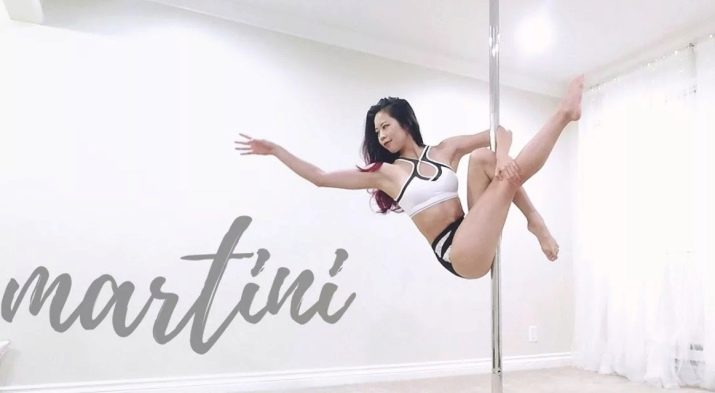
- "Tulip". The upper hand is in a band grip, the lower hand is in a space. You need to swing your leg out of the pylon, turn the body with your chest up, bend in the back. Keep both arms straight, legs together, you can bend one at the knee.
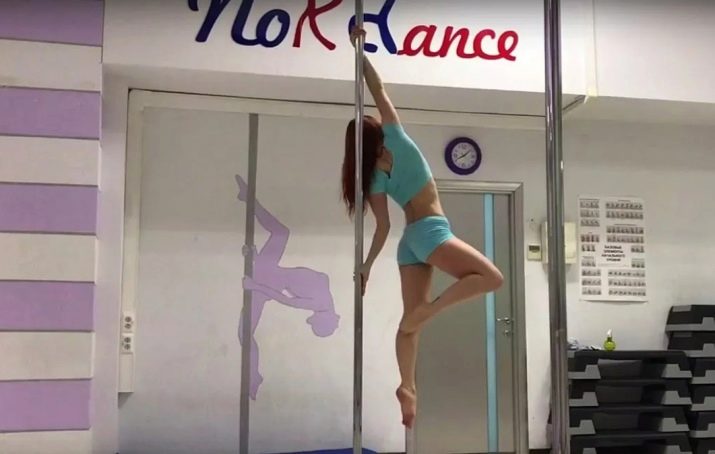
- "Titanic". Element for the middle level. First, there is an exit from the "Superman" element, then the leg and the hand that holds the pylon go down. The inner part of the foot is placed on a pole, and she presses heavily into it. The second leg is lowered, the hold between the knees is maintained.
You need to pull yourself up with the hand that is holding onto the pole, with your free hand grab it from above. An emphasis on the shoulder, one hand is released to the side.
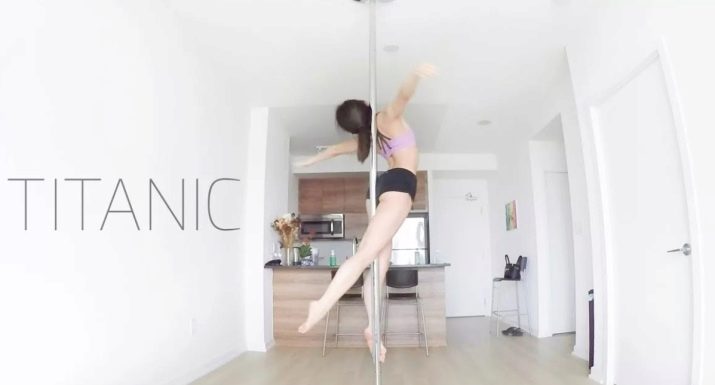
- "Four". Sit on the pylon, bend one leg on top at the knee, leave the other straight. Then, using the support with your hands, lean back upside down. Hands should be brought together in front of the chest, but another, arbitrary position is also possible.
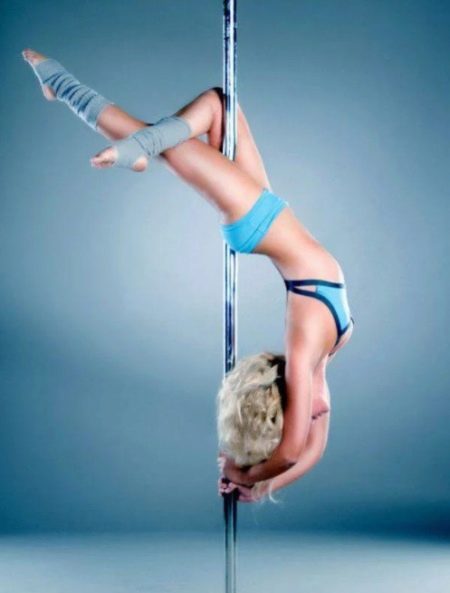
- "Flag". This is a difficult (comparatively) element, for its successful implementation you need a comfortable grip, swing, as well as an inserted shoulder.
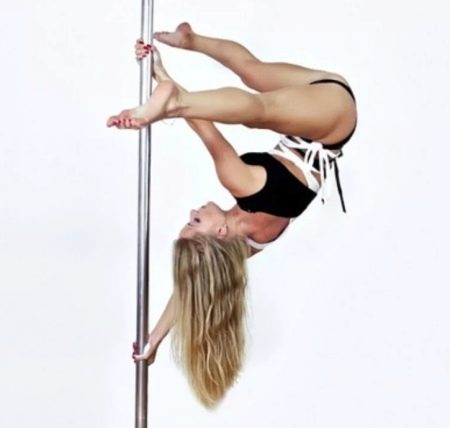
- "Scorpion". First there is an exit to the slingshot, then to the hanging on the far leg. The near upper limb goes down, the hand - “ring” down. The body is moved along the pylon, the free leg is slightly bent. The head tends to the free leg, the deflection in the back is fixed.
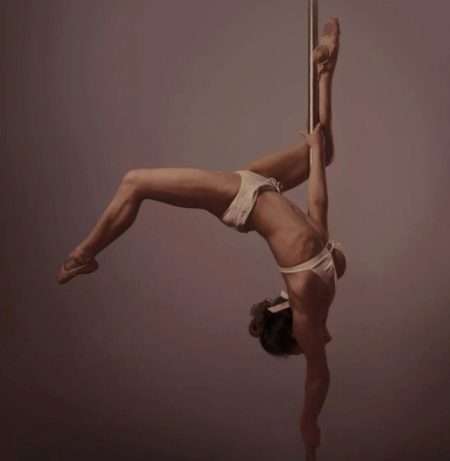
Difficult stances, acrobatic stunts requiring considerable preparation, as well as pair performances - all this in perspective. Those who have mastered the beginning, did not give up, withstood the pace and requirements, will definitely come closer to success.
What is necessary?
Such things are needed for classes.
- T-shirt or T-shirt, you can top. The stomach, arms and shoulders, preferably, should be open, because a gymnastic leotard will definitely not work.
- Shorts, because the legs should also be open. And the point is not in the degree of exposure, but in how the fabric will slide along the pylon. Here you can use leggings.
- Dance ballet flats, gymnastics shoes are suitable as shoes., as well as sneakers for dancing, jazz shoes, you can wear soft ballroom shoes. But they do barefoot too, all for the sake of optimal grip with the pylon. Strips are only for certain types of pool dance and definitely not for beginners.
- Fingerless gloves, which will prevent wet palms from sliding off the pylon, and also protect from calluses and other rubbing.
- Gels, sprays, waxes, powders - any means that improve the adhesion of the skin and the pylon.


You may also need an elastic wrist bandage to prevent injury. Well, and where without musical recordings, they accompany both training and performances.
How to learn to dance?
Learning from scratch is a challenge for any kind of physical activity. If a person has already done choreography, gymnastics or acrobatics, it will, of course, be easier for him. But nevertheless, the specificity is taken into account, and the degree of ease of entry into training is different, even among experienced people.
How is a standard pool dance lesson going?
- Warm up or warm up. The stage is obligatory, and it lasts 15 minutes for sure. Muscles and ligaments must be ready for physical activity, therefore, without a warm-up, training can become traumatic.
- Basic static elements. It is the statics that begins the main training program, gradually the pace and scale of movements will increase.
- Dynamic exercises. The body is already ready to perform twists, turns, flips and other tricks.
- Difficult stretch marks. Pool dance is inconceivable without flexibility, and this requires a lot of time in class - a whole block.
- Strength exercises. At this stage, you can train supports, hangs, stands. At this time, there is always a safety mat near the pylon.
- And again stretching, but not so intense.
- Hitch. As with any workout, it completes the main part, that is, exercises are proposed that are already performed in slow motion. By the way, yoga is very suitable here, many of its exercises help to successfully get out of activity into slowing down, to reflect.
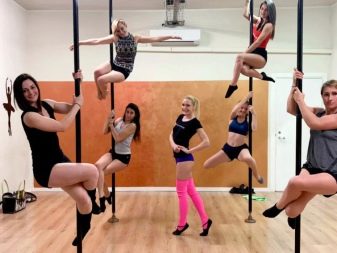
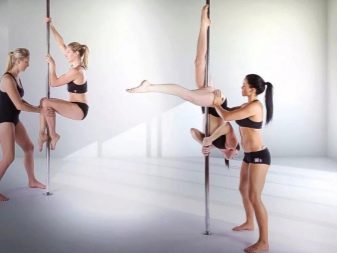
Beginners usually train for an hour and a half, those who are more experienced - an hour and a half to two hours.
Review overview
There are a lot of reviews on pool dance on the Internet: both from those who "rushed" to advertisements, and from those who were doing this for some number, almost at a bachelorette party, as well as from those who went to fight their own complexes ...
What are the advantages of most of the reviews:
- very high loads - you can bring the body back to normal quickly, and lose weight, and build a beautiful muscle corset;
- music lessons are always more interesting than sports, at least for those who were not very fond of physical education at school;
- puldance lessons greatly affect self-perception, awareness of one's own femininity;
- you can learn a lot in a quick time, the training is quite intense;
- it stuns all acquaintances - someone openly admires, someone cannot believe;
- if you need to work out some psychological complexes, pool dance does an excellent job with this.
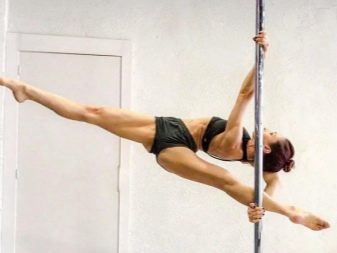
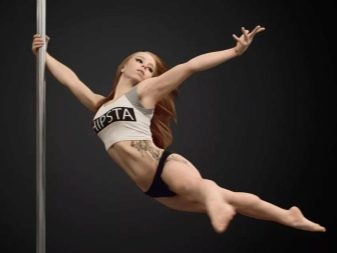
Negative statements are also not complete. Oddly enough, the main "disadvantages" are the complexity, the inconsistency of the load level with expectations. The women write that they were sure of the availability of pool dance, but it turned out that after the first lesson they barely made it home. Actually, the winners were those who were not afraid and came to the lessons again. And for those who were scared and took pity on their poor body, pool dance with its expression and discipline is not suitable.
Other disadvantages of pool dance that are noted in reviews:
- it is impossible to practice at home (no pylon);
- sometimes the coach clearly devotes more time to the talented, the average person does not have enough attention;
- there is nowhere to show skills - not everyone has the opportunity to go to championships, competitions, festivals;
- the first classes may turn out to be a failure, not everyone can endure some progress;
- not everyone succeeds in overcoming the psychological barrier, opening up, not being afraid of complex and effective tricks.
Perhaps you shouldn't go to classes for the company, with a girlfriend. You need to develop readiness for such training, burn with them, because tightness and lack of concentration will not be able to work out normally. In general, pool dance is also interesting because it develops.If one of its directions becomes an Olympic sport, a surge in popularity will clearly happen, and it will be honorable and interesting to be already in the subject.
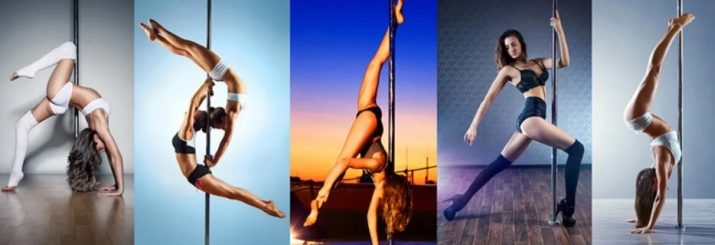
For information on where to start when starting this dance direction, see below.








